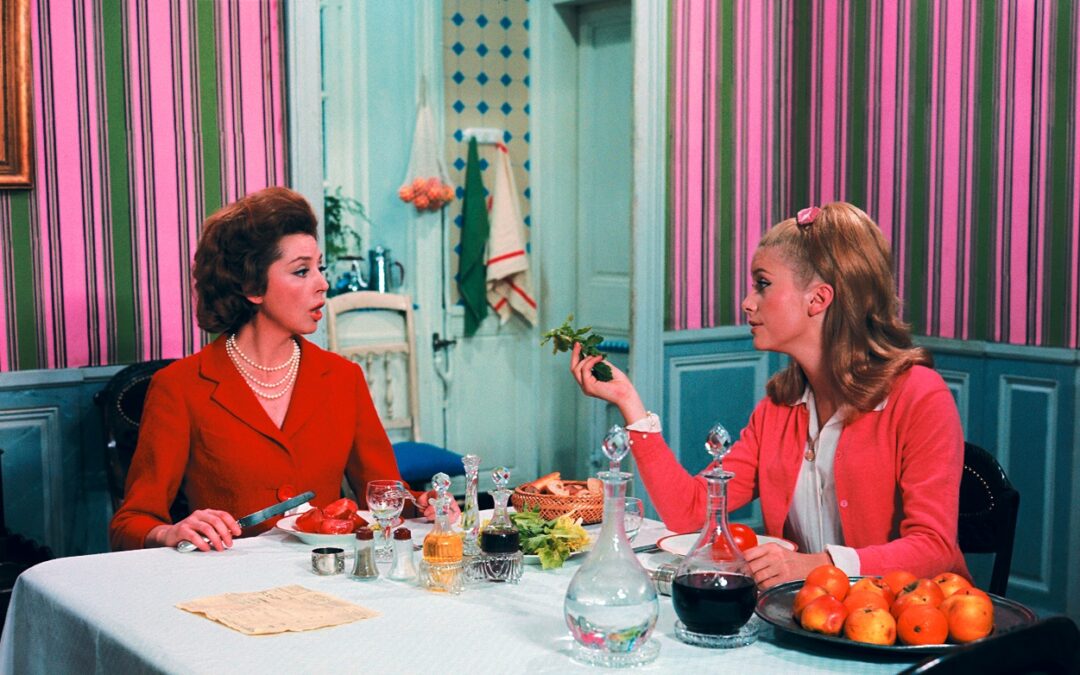Blog
Is there Wi-Fi here?
Analysis of a Frame: The Umbrellas of Cherbourg
Year: 1964
The Frame
Jacques Demy’s 1964 musical film, The Umbrellas of Cherbourg, tells a brilliantly crafted story about the dichotomies of life—success and hardship, youth and maturity, love and heartbreak. Gorgeous shots by cinematographer Jean Rabier, vibrant set pieces, and memorable characters turn a story of star-crossed lovers kept apart by an obligation to family, duty to country, and class expectations, into a cinematic experience.
The Umbrellas of Cherbourg focuses on the multi-generational struggle of pragmatism versus the optimism and naivety of youth. The growing tension between Genevieve and her mother is evident in this frame.
The scene magically and movingly come to life with a vibrant two-dimensional perspectivity, displaying color-coordinated characters, boldly and beautifully blending in with their surrounding environs and wallpapered interiors. The beautiful color scheme: florals, prints, and block colors, become 3-d with items which seem to jump off the palette: the yellow lemons, the bouquet of flowers, the pitcher of water, and the wine glasses.
The Red Suit and The Pink Sweater
Here we see Deneuve dressed in a vibrant pink sweater, seated diagonally from her mother clad in a buttoned red suit. In the background, the wallpaper is striped pink and green. The choice of clashing colors brings violence and strength to the scene’s look. On the surface, the story seems so sweet, like a romance. However, in reality, the story is about a class struggle, with the bourgeois mother determined that her teenage daughter not marry her young sweetheart, the garage mechanic, Guy (Nino Castelnuovo), with whom she is smitten. However, Mme. Emery will stop at nothing to ensure that Genevieve marries a wealthy diamond merchant played by Marc Michel. In the hopes that this cultured (but somewhat cold) man of travel will raise their social aspirations.
The Red Tomato
Noticeable in the frame is the red cherry tomato on Genevieve’s plate. The tomato matches her middle-aged prejudiced, and insecure mother’s red suit. It is clear from this frame that Genevieve is being force-fed her mother’s values while dressed in a romantic girlish pink sweater (now open and unbuttoned in contrast to the earlier scene). The extent of Genevieve’s conflict is referenced by the contrasting green leaf in her hand.
The Blue Chair
While only two characters are in the scene, the shot is wide enough to see the empty chair separating the mother and daughter.
It is clear from this shot and so many other breathtaking frames in the film, The Umbrellas of Cherbourg that Demy and cinematographer Jean Rabier succeeded in creating a non-artificial world, anchoring the film’s pure visual poetry to the specifics of urban reality. Leading the film shot in 1964 to have an everlasting place in cinema and remain one of the greatest films.
Kudos to Demy’s widow, Agnes Varda, for her careful reconstruction in which Demy’s 1960 colors, including bright pink, reds, purples, and oranges, continue to mesmerize audiences.

Barren: A Film Review
Film: Barren
Year: 2022
Writer and Director: Rav Mordechai Vardi
Starring: Mili Eshet, Yoav Rotman, Ilanit Ben-Yaakov
Nomination: Haggiag Competition for Israeli Feature Films
Synopsis: A childless young ultra-orthodox couple faces a crisis after a traumatic treatment for barrenness. When the difference between good and bad is unclear, the family must deal with unresolved secrets that raise fundamental questions about religion and faith.
When 2+2 Does Not Equal Four
Last night, I was privileged to attend the International Premier of Director Mordechai Vardi’s first feature firm, Barren.

You are struggling.
You are offered a fix. A solution. A cure.
You take the person up on their offer – can you not?
Writer and Director Harav מרדכי ורדי Mordechai Vardi tackles this challenge in his new film #Barren currently screening at the Jerusalem Film Festival.
What happens when 2+2 does not equal 4? What happens when you feel completely alone? Nowhere to go. Nowhere to turn.
You try and hold it together, your way, the way you are capable of, at the time. Instead, they beg you to “put on a smile” – have a cup of tea. And then sometimes you go out into the forest and scream – why? Why? Why?
The Need to Be Heard
Harav מרדכי ורדי, you hear the cries of anguish. Her screams – his screams – our screams. You don’t shy away from authenticity. Yes- there are parts of the movie when her hair is uncovered. Yes- a young couple loves each other. Yes- Harav Vardi, you let us be voyeurs in a young couple’s bedroom. Witness their intimacy, for a crucial moment, before you, Harav Vardi, turn off the lights. Yes- Harav Vardi, you invite us into the men’s only, beit din. Yes- we cringe when we hear how the halacha is clear, there was no rape since she “let him” perform voodoo on her.
The Courage to Hear
Thank you, Harav Vardi, for your courage. Your insistence on authenticity. Your tackling of such a challenging subject. For not shying away from such a loaded theme.

The Desire to Engage
This viewer left the theater with more respect, understanding, compassion, and empathy for the Beit Din. For the Rabbinic community. More feeling for the protagonist, whose choices are what’s suitable for her— not for me and so many of us prepared to judge her.
“Barren,” directed by Harav Mordechai Vardi, features delicate, nuanced performances by a terrific cast – including one of my favorite teachers in the role of doctor!

The Strength to Continue
Harav Vardi, May Hashem grant you the strength to continue telling our stories. B’ezrat Hashem, this viewer, will summon the strength to witness the truth unfold.
Jerusalem Film Festival 2022
Shoutout to the Jerusalem Film Festival for providing a platform for this important conversation!
Click here to discover all the awesome films being screened at the 2022 Jerusalem Film Festival.
What were your thoughts about Writer and Director Mordechai Verdi’s feature film, Barren?

Most Popular Posts
Tu B’Shevat Trip Guide